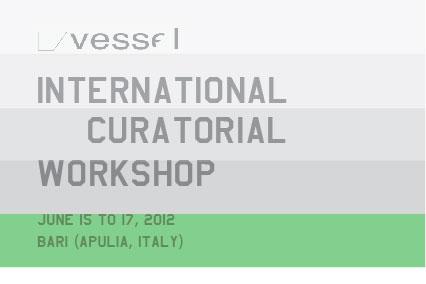The first day of the workshop started with a discussion on how to further vessel’s practice in light of the specific challenges of interacting with an area marginal to the dominant art market. Rachel Pafe further elaborated upon this in her comparative study analyzing the strategies and tactics that Group Material, an artist collective, used in the 1980s and vessel is currently appropriating in its context of development. Francesco Scasciamacchia presented the practices of Chto Delat, an artist collective, which used unique collaborative performance tactics in order to further social and political change. Charles Esche, moderator of day one, contextualized the topic by focusing on the exhibition as the point crystallization and dissemination of canonic ideas, using the term “when attitudes become form”. He provided examples of historical exhibitions that contribute the basis for our current interpretation of art juxtaposed with the rhetoric that we can use the exhibition format as a means of interacting with broader history.
After these initial case studies, participants divided into two groups and discussed exhibitions that they felt were or will soon be historically important. After deciding upon two exhibitions to present to the conference, the groups came together, presented the studies, and examined their challenges in terms of marginality and reasons for canonization.
The next day of the workshop was led by Galit Eilat, who presented her eight-month curatorial project, Liminal Spaces, which aimed at challenging the dynamics of occupation of Palestinian territory along the Israeli border. This was actively developed through a series of discussions, meetings, research, and site-specific work, using art as a means of navigating the challenges of freedom, deprivation, and mobility. After this, Nia Roberts led a discussion about Whales as a marginal entity in terns of the 2011 Venice Biennial. Sequentially, Bori Szalai presented The Újlak group and the Little Warsaw in the context of post-1989 Hungary, providing further illustration of tactics within peripheral space. After this, participants presented potential curatorial projects and the group discussed the various challenges and weak points within the strategic planning.
The last day, June 17th, focused on the presentation of ICW 2011 publication, written by ICW 2011 members including major contributions by Jerlyn Jareunpoon. Other authors, Francesco Scasciamacchia and Viviana Checchia, shared the text, which was followed by a discussion for the formalization of its outcome. This was a time in which to discuss the future direction of vessel and its curatorial methods. How can we formalize ICW for next year? Topics included private versus public forums, combination of horizontal and vertical formats, and distribution of research topics among participants.
The workshop served as a platform for discussion and experimentation, a starting point for education, discussion, but most importantly, future collaboration.
Rachel Pafe







Comments 1
Say something